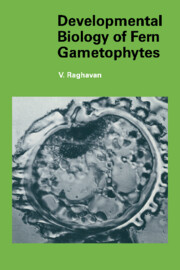Book contents
- Frontmatter
- Contents
- Preface
- Abbreviations
- 1 Introduction
- PART I THE BEGINNING
- PART II GROWTH AND MATURATION
- PART III REPRODUCTIVE STRATEGIES
- 10 Control of differentiation of sex organs on gametophytes
- 11 Sexuality and genetics of gametophytes
- 12 Gametogenesis and fertilization
- PART IV DEVELOPMENTAL OPTIONS
- References
- Author index
- Subject index
10 - Control of differentiation of sex organs on gametophytes
Published online by Cambridge University Press: 11 September 2009
- Frontmatter
- Contents
- Preface
- Abbreviations
- 1 Introduction
- PART I THE BEGINNING
- PART II GROWTH AND MATURATION
- PART III REPRODUCTIVE STRATEGIES
- 10 Control of differentiation of sex organs on gametophytes
- 11 Sexuality and genetics of gametophytes
- 12 Gametogenesis and fertilization
- PART IV DEVELOPMENTAL OPTIONS
- References
- Author index
- Subject index
Summary
Gametophytes of homosporous ferns acquire the potential to form antheridia and archegonia during a period of growth and maturation. A striking aspect of sexuality in fern gametophytes is the complexity of the division sequences giving rise to sexual cells and the simplicity of the final products. Initiation of sex organs (gametangia) on the gametophyte thus poses important developmental questions inasmuch as certain cells in a homogeneous population respond to reprogramming cues and differentiate into gametes adapted for sexual recombination. What is the trigger that starts off cells of the gametophyte on a particular course of metabolism and behavior which will turn them into antheridia and archegonia? Analysis of this question has been an important thrust in the developmental biology of ferns and as a result there is strong evidence to show that antheridium formation on the gametophyte occurs in response to hormonal signals. The controlling factors in the initiation of the archegonium have as yet been hardly considered, but the challenge is great.
In this chapter we emphasize the ontogeny of the antheridium and archegonium and follow it up with a discussion about the physiological control of their differentiation. Beginning with a survey by Näf (1962b) which was partially devoted to the physiology of antheridium formation in fern gametophytes, new knowledge gained in the field has been incorporated into periodic reviews (Näf, 1963, 1969, 1979; Näf, Nakanishi and Endo, 1975; Voeller, 1964a; Voeller and Weinberg, 1969).
- Type
- Chapter
- Information
- Developmental Biology of Fern Gametophytes , pp. 199 - 220Publisher: Cambridge University PressPrint publication year: 1989



